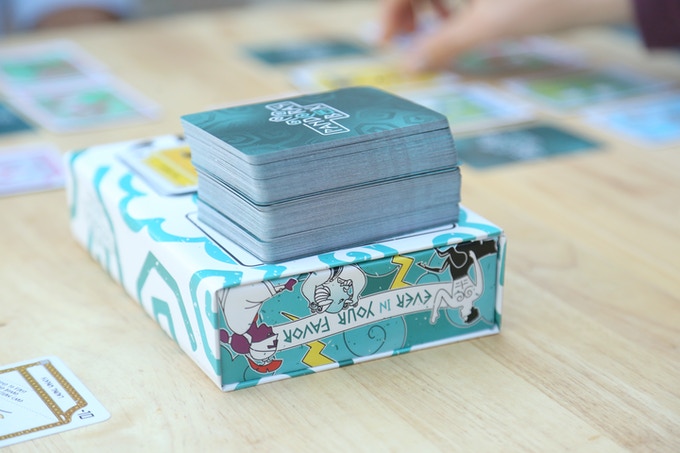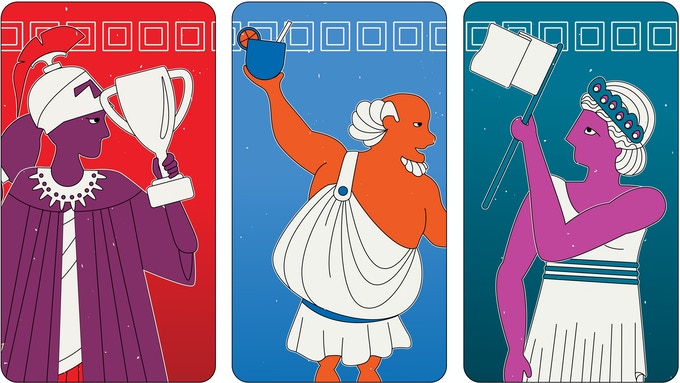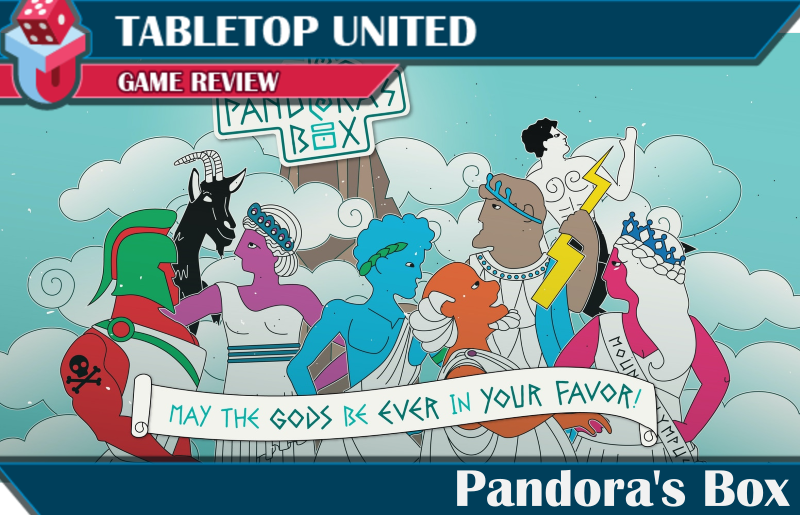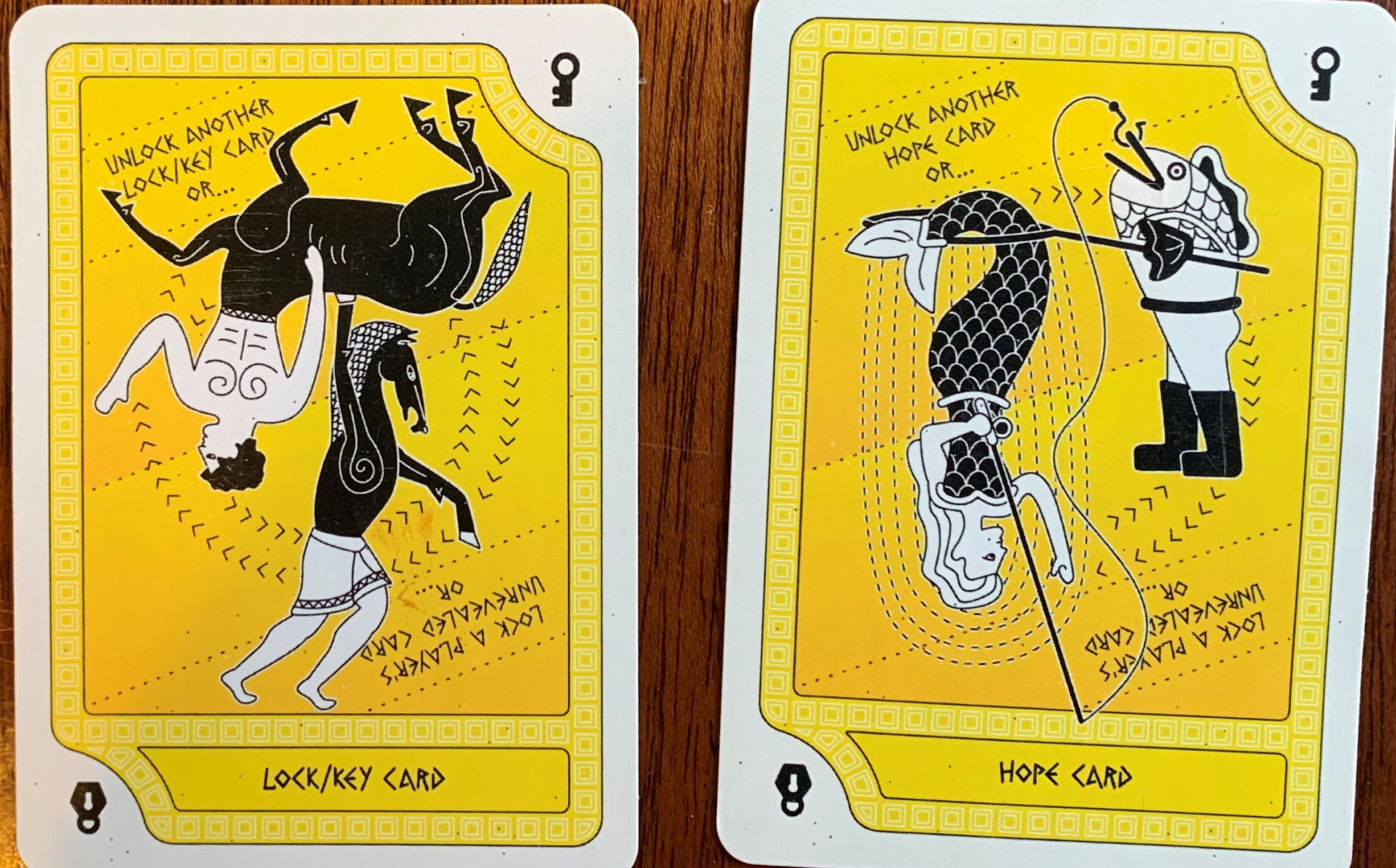Pandora’s Box
Designer: Nathan Rigby
Artist: Michelle Monson
Publisher: Self Published
Year Published: 2020
No. of Players: 2–5
Ages: 7+
Playing Time: 15 minutes per round
Main mechanic / Theme: Set Collection, Stacking and Balancing / Modernized Greek Mythology
Can you appease the gods with the homage you pay them?
Find more info on Kickstarter.
Overview
Pandora’s Box is an easy to learn card game to be played at the table. It contains a simple strategy that is like the game Golf, played with standard playing cards. The objective is to complete your columns and to score as little as possible. You can even score negative points if you play your cards right.
Pandora’s Box can be played very straight forward, which works well for younger players. It also has a higher level of strategy of deciding where to draw a card from and where to play it. There are even times you might consider playing a card differently so another player can’t use it.
The game continues for as many rounds as you decide. When the final round is over, the lowest score receives the blessing of the gods.
To get to the games namesake there are additional cards to lock and unlock cards in place along with curses that lead to Pandemonium. Pandemonium causes a quick change in activity because, depending on which curse, cause the person who drew the card, another player, or all players to turn the cards in their playing area faced down, mix them up, and reset their tableau.
Gameplay and mechanics
Objective
The objective of Pandora’s Box is to create matching columns. The score of a matched pair in a column is zero, and the lowest score wins. If you can create matching columns that are next to each other in sets of four, six, or eight, you gain a negative points bonus for creating a Midas Touch.
Setup
Each player begins with eight cards. They are laid face down to create two rows, or more importantly four columns. There is also a place for The Underworld. The Underworld is the player’s individual discard pile.
In the center of the table are two more locations. Mount Olympus is the general draw pile. The River Styx, for discarding.
First Turn
The first turn is different because you need to start by revealing two of your cards. The two cards are revealed. There are three outcomes depending on if they are both God cards, or if you reveal a lock or a curse.
Normal Turn
On your turn you draw a card. You can take the top card from either Mount Olympus (general draw pile) or from another person’s Underworld (personal discard pile). This is where some of the advanced strategy comes into play. You need to keep a watch on what other players have on the top of their pile and what they are playing in front of them. Put the wrong card on the top of your pile and you might be giving someone else a large negative score for the round.
You decide where to play the card if it is a God card. It can replace any of the cards in your playing area that are not locked. A locked column is where both cards are revealed. These cards can’t be replaced unless it is a locked card and you’re using a key card to unlock it. You can only place drawn cards into unlocked columns.
If the card is already revealed, then the replaced card is moved to your Underworld. If it starts out facedown, the card is revealed and could start a chain reaction of play. When this newly revealed card matches an already revealed card in an unlocked column you can replace the hidden card with the new one to create a matched pair in the column. If it happens again, continue building columns.
Final Round
When someone has completed all four columns the final round begins.
In order, the players reveal their cards. You don’t get to move them around as in a normal turn. However, if you turn over a lock or a curse, that card is played. This can cause Pandemonium, which can move the game back into normal turns.
When everyone has revealed all their cards you add up the amount on non-paired columns. The number in the top corner is the value of the card. Columns that are paired are zeroed. If you have larger collections of matched God cards you receive a negative bonus. A negative bonus also goes to the person to first complete all four columns in the round.
The game can end after a single round, lowest score wins. You can also decide to play several rounds and keep track of the score for a total at the end.

Theme, Artwork and Illustration, Graphic Design and Layout
Throughout the cards and the rules there is the playing back to the Greek Gods. This isn’t taking a serious look at the Gods from mythology. There are modern additions to the pictures and the tag lines on the cards. They are added for fun. Younger players will get a laugh out of a Greek God consulting a Magic 8 Ball, or Hera being tagged “Supermom.”
The mechanic is draw and play to create sets on how the cards are placed. Straight forward and easy to learn. This can be played with younger players as they work to make pairs and sets. Older players can be involved in a little more strategy as they determine where they need to draw from and where they need to lay the card down.
This is a pre-production copy. The artwork is designed for the fun side and not the serious side of the Greek Gods. There is a larger than standard number of cards in the deck to include the locks and the curses.

What worked
One nice aspect of Pandora’s Box is you get to decide how long you want your game to last.
Final thoughts
Pandora’s Box is a good game for playing while you want to socialize. It doesn’t require heavy thought in the strategy - check the field of play in front of you and what others have done before taking your turn. Once you are done, you don’t have to be focused in to see how the table changes until it is back around to you.
Players who like Golf (with standard playing cards) will find there are strong similarities to Pandora’s Box.

About the Author
Daniel Yocom does geeky things at night because his day job won't let him. This dates back to the 1960s through games, books, movies, and stranger things better shared in small groups. He's written hundreds of articles about these topics for his own blog, other websites, and magazines after extensive research along with short stories. His research includes attending conventions, sharing on panels and presentations, and road-tripping with his wife. Join him at guildmastergaming.blogspot.com.
If you enjoyed this content, please consider joining our Facebook page, community Facebook group, following us on Twitter, or, by joining our newsletter.

